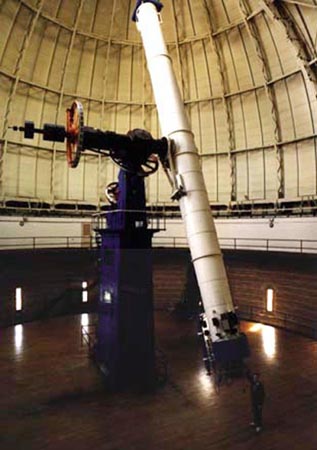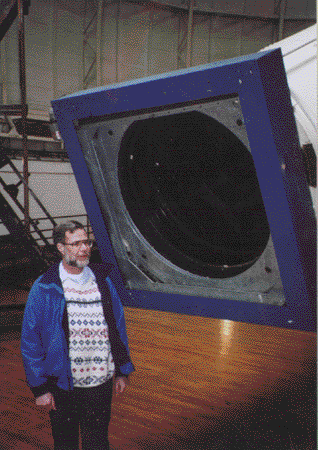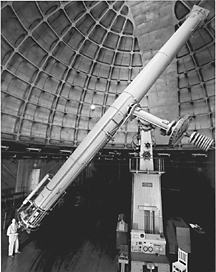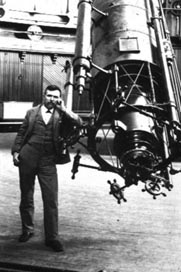Video lecture for this chapter
This material (including images) is copyrighted!.
See my copyright notice for fair use
practices. Select the photographs to display the original source in
another window.
There are two basic types of telescopes, refractors and reflectors. The
part
of the telescope that gathers the light, called the objective,
determines the type of telescope. A refractor
telescope uses a glass lens as its objective. The glass lens is at the
front
of the telescope and light is bent (refracted) as it passes through the
lens. A reflector telescope uses a mirror as its objective. The
mirror is close to the rear of the telescope and light is bounced off
(reflected) as it strikes the mirror.
The refractor telescope uses a lens to gather and focus light. The first
telescopes built were refractors. The small telescopes sold in department
stores are refractors, as well as, those used for rifle scopes.
- Refractor telescopes are rugged. After the initial alignment, their
optical system is more resistant to misalignment than the reflector
telescopes.
- The glass surface inside the tube is sealed from the atmosphere so it
rarely needs cleaning.
- Since the tube is closed off from the outside, air currents and effects
due to changing temperatures are eliminated. This means that the images are
steadier and sharper than those from a reflector telescope of the same
size.

Though excellent refractors are still made, the disadvantages of the
refractor
telescope have blocked the construction of very large refractors for use in
astronomical research.
- All refractors suffer from an effect called chromatic
aberration (``color deviation or distortion'') that
produces a rainbow of colors around the image. Because of the wave nature
of light,
the longer wavelength light (redder colors) is bent less than the shorter
wavelength
light (bluer colors) as it passes through the lens. This is used in prisms
to produce
pretty rainbows, but can it ruin an image!

There a couple of ways to reduce
chromatic aberration. One way uses multiple compensating lenses to
counteract
chromatic aberration. The other way uses a very long objective focal
length
(distance between the focus and the objective)
to minimize the effect. This is why the early refracting
telescopes were made very long.
- How well the light passes through the lens varies with the wavelength
of the
light. Ultraviolet light does not pass through the lens at all.
- How well the light passes through decreases as the thickness of the
lens increases.
- It is difficult to make a glass lens with no imperfections inside the
lens and
with a perfect curvature on both sides of the lens.
- The objective lens can be supported only at the ends. The glass lens
will sag under its own weight.
Because of these disadvantages, the largest refractor telescope built is
the one
at Yerkes Observatory. It has an objective 1.02 meters (40 inches) across
at one end of a 19.2-meter (63 feet) tube. The two
largest refractors are shown below. The first picture is the 40-inch
refractor at
Yerkes Observatory.
Clicking on the image will lead you to more information about
this telescope (and better pictures!) in another window. The second picture shows an
astronomer (Kyle Cudworth) next to the objective to give you an idea of the size of the
telescope. Notice the size of the people in the first picture! The third picture is
the 0.91-meter (36-inch) refractor at
Lick
Observatory.
Notice the astronomer at the lower left.
Clicking on the image will take you to the Lick Observatory webpage about the telescope in another window. The last
picture is E.E. Barnard at the eyepiece of the Lick 36-inch.



 .
.
 Go back to previous section --
Go back to previous section --
 Go to next section
Go to next section
last updated:
January 19, 2022
Is this page a copy of Strobel's
Astronomy Notes?
Author of original content:
Nick Strobel



![]() Go back to previous section --
Go back to previous section --
![]() Go to next section
Go to next section